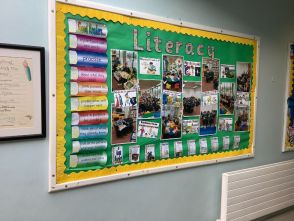- Home
- Curriculum
- Language & Literacy
Language & Literacy
Literacy focuses on developing each child’s ability to understand and use language as an integral part of learning in all areas in order to interact effectively with the world around them, to express themselves creatively and to communicate confidently (through Talking and Listening, Reading and Writing) using a variety of skills and media. Language and Literacy are fundamental prerequisites for thinking, learning and interacting in personal, social and work contexts throughout life. Literacy is therefore a key to learning as well as a key to enjoyment and personal growth.
Foundation Stage
Children in Years 1 and 2 follow a very structured phonics programme based around the principles of Linguistic Phonics. Running alongside this is a structured sight vocabulary programme. This includes children in P.1. being introduced to 50 key words. By the end of P.2. children will have been exposed to 100 key words. As well as reading key words, they also can read a wide range of sight vocabulary from their work done in their topics. The children learn to recognize and write all lower and upper case letters. Towards the middle of P.1. most children will be able to attempt to write a sentence independently. By the end of P.2. many children will be able to compose several sentences independently.
Key Stage 1 and 2
By the time a child enters P.3. he/she will be ready to approach the more content driven curriculum. The school’s highly structured phonics programme continues throughout the years alongside a highly structured spelling programme.
The school has also devised Writing schemes accounting for all genres . Each class has to produce samples of writing in these areas which is closely monitored by the class teacher; the Literacy co-ordinator as well as the full teaching staff through focus group meetings. Each child produces set samples which are edited several times using different criteria.
Reading is highly structured in Key Stage 1 using the Oxford Reading Tree texts alongside other texts. However, as children progress in to P.6. and P.7. reading is normally directed from the use of novel studies. There is a daily Literacy Hour in all classes where the children are taught both the mechanics of reading as well as the higher order skills. Children then consolidate these approaches at home.
There are also many Literacy initiatives that support the main Literacy Programme in the school. Such initiatives include Book Character Day, readathons, two book fairs etc. Children are given many opportunities to read and write for wider audiences such as at assemblies, letters of petition etc.
Progress is monitored through the use of class tests, diagnostic testing, standardized testing and end of Key Stage testing. Parents are given clear and accurate feedback about their child’s progress.
St. Patrick's Primary School Mullanaskea,
Garvary, Enniskillen,
County Fermanagh, BT94 3AD
028 6632 6539
WEBSITE BY: SCHOOLWEBDESIGN.NET | Login
 Menu
Menu

